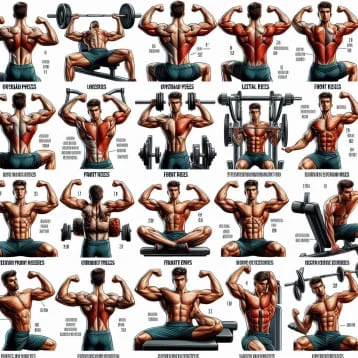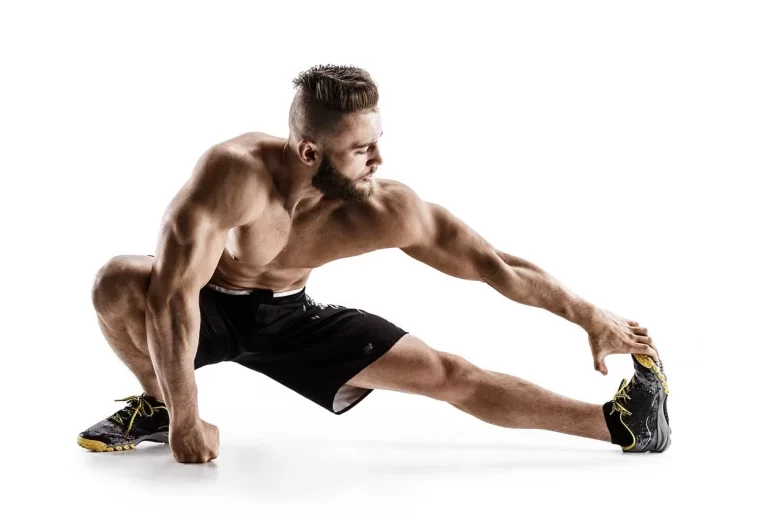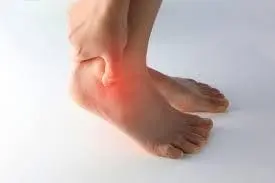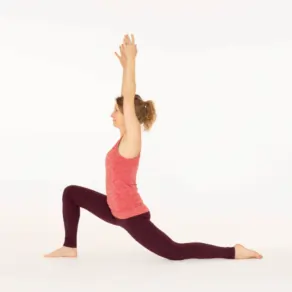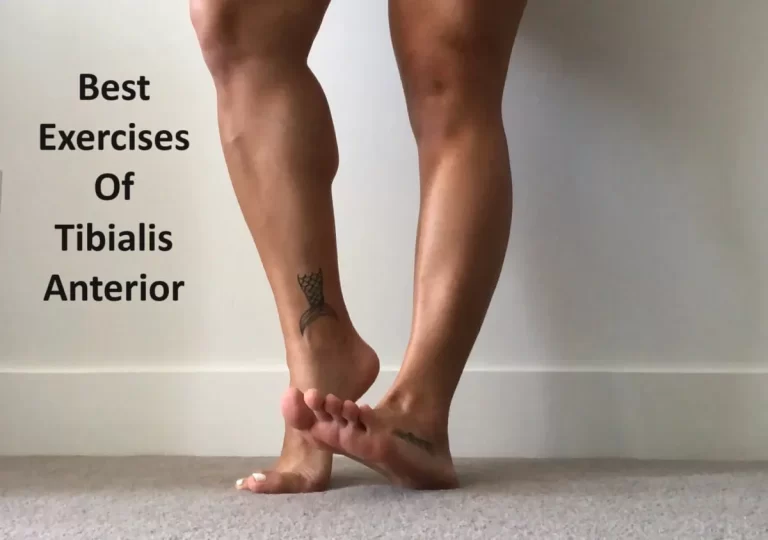33 Best Deltoid Muscle Exercises
Deltoid muscle exercise is a vital component of any comprehensive strength training regimen, particularly for those aiming to develop well-rounded shoulder strength and aesthetics. The deltoid muscle, commonly known as the deltoid or delts, is a prominent muscle group located on the shoulder.
Comprising three distinct heads – the anterior (front), medial (middle), and posterior (rear)—the deltoids are responsible for a wide range of shoulder movements, including lifting, pushing, and rotating the arm. Strengthening exercises targeting the deltoids play a crucial role in enhancing shoulder stability, mobility, and overall upper-body strength.
What are the deltoid muscles?
- The glenohumeral joint is covered by the massive, triangular Deltoid muscle, which is responsible for the rounded appearance of the shoulder.
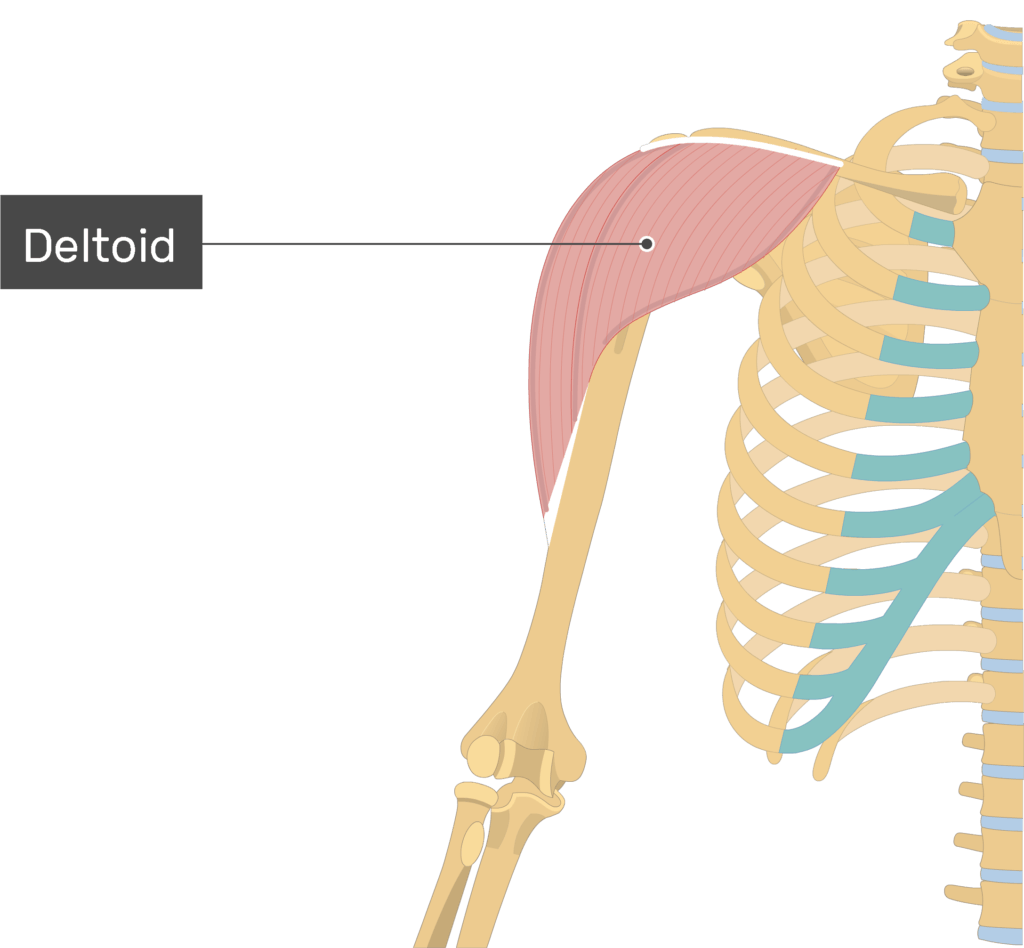
- The ball-and-socket joint in your shoulder that joins your arm to your body’s trunk contains your deltoid muscles. Additionally, they stabilize and protect your shoulder joint.
- The deltoids are skeletal muscles, just like the majority of other muscles in your body. Tendons bind them to the skeleton. You can choose to move your skeletal muscles since they are voluntary muscles. Smooth, or involuntary, muscles—like the heart—that function automatically are not the same as skeletal muscles.
- The anterior, or clavicular, middle, or acromial, and posterior, or spinal, segments make up its three separate sections.
- It functions primarily as the humeral head stabiliser and shoulder abductor. It also aids in forward elevation.
- The deltoid is a powerful muscle that is used in a variety of ADLs (such as carrying shopping bags and brushing your hair) as well as sports (such as swimming, water polo, netball, and volleyball).
What function do the deltoid muscles provide?
Along with other shoulder muscles like the rotator cuff muscles, the deltoid muscles enable you to perform a range of actions. Functions of the deltoid muscles include:
- One of the deltoid’s primary roles is to stabilize the shoulder joint, especially when bearing weight, by avoiding subluxation or even dislocation of the humeral head. The primary force behind shoulder abduction is the deltoid.
- The abduction of the shoulder joint is produced by the cooperation of all the deltoid heads. It aids in raising the arm’s front, side, and posterior. Deltoid soreness can affect anyone who engages in repetitive overhead activity. Examples of these people are house painters, swimmers, water polo players, and pitchers. In order to avoid subluxation or dislocation, it is also active when carrying goods, such as bags, or reaching for objects.
- Recompense for diminished upper limb strength in the event of an injury, like a rotator cuff tear.
- Extension (extending your arm backward, behind your body) and Flexion (pushing your arm forward, into an above position).
What is the importance of deltoid muscle exercises?
Shoulder Stability: One of the body’s most dynamic and intricate joints, the shoulder depends on the deltoid muscles for stability. By keeping the shoulders stable and in the right position, strengthening these muscles lowers the chance of shoulder injuries from everyday activities and sports.
Functional Movement: A range of arm and shoulder functional movements, including lifting, pushing, pulling, and rotating, are made possible by strong deltoid muscles. Smoother and more efficient actions are facilitated by having well-developed deltoids, whether you’re throwing a ball or reaching for something on a high shelf.
Athletic Performance: For peak performance, athletes in sports like tennis, basketball, volleyball, swimming, and biathlon significantly depend on their deltoid muscles. Robust shoulders enhance throwing precision, upper body strength, and the capacity to produce force during upper limb motions.
Support for Posture: Rounded shoulders and a forward head posture might result from weak deltoid muscles. Frequent deltoid exercise helps build stronger shoulder girdle muscles, which improves posture and lowers the chance of postural abnormalities and the pain they cause.
Injury Prevention: Rotator cuff strains, impingement syndrome, and shoulder dislocations are among the common shoulder injuries that can be avoided by strengthening the deltoid muscles. Deltoid exercises enhance the stability and muscle balance of the shoulder complex, making it more resistant to injuries.
Aesthetic Benefits: A well-defined deltoid muscle mass improves the upper body’s overall appearance, resulting in the desired “V-shaped” physique. In addition to enhancing symmetry and proportion, well-defined and toned shoulders also increase self-assurance and self-worth.
Exercises for Deltoid Muscles:
1. Deltoid strengthening exercises
Isometric Deltoid Contraction
keeping back and elbows straight when standing close to a wall. As hard as you can without hurting yourself, gently press the arm against the wall. Hold for 10 seconds and repeat 5 to 10 times on each side as long as there is no pain.

The advancement
Appropriate dumbbell weight and anterior, lateral, and posterior arm lifts. As long as there is no pain, repeat ten times on each side.
Resistance band pullbacks, lateral raises, and forward increases. If there is no pain, repeat each side ten times.
Additional advancement
There are many different versions. activities such as high-side plank walking, forward arm lifts with squats, and shoulder-diagonal PNF with a band.
Anterior Deltoid Raise
Benefits: This exercise, which focuses on the anterior head of the deltoid muscle, is one of the best anterior deltoid exercises. It aids in developing the strength required to raise things in front of you.
How to perform this workout for strengthening:
The patient must perform this exercise by standing with their feet hip-width apart and holding a dumbbell in each hand while keeping their arms by their sides.
With your hands facing each other, slowly raise a dumbbell straight in front of you to shoulder height while maintaining a straight-arm posture.
progressively Return to the beginning position and repeat.
Perform one to two sets of ten to twenty repetitions.
Front lift in a neutral grip
How to Proceed:
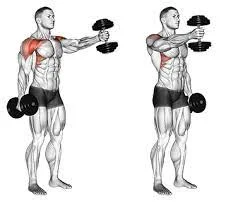
Hold a dumbbell in both hands.
Tension your abdominal muscles while keeping your back straight.
Lift the weights until your arms are shoulder height in front of you and your palms are facing one another.
Gradually move the weights back to where they were initially.
There should be ten attempts.
Shoulder press at an angle
How to Proceed:
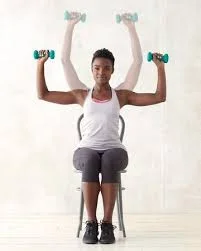
Your feet should be hip-width apart.
Using both hands, raise a dumbbell.
Raise the dumbbells to shoulder height and twist them outward at a 45-degree angle while keeping your elbows tucked up at your sides.
With your elbows straight, raise your arms above your head.
Gradually revert to your initial position.
There should be ten attempts.
Y-raises
How to perform Y-raises:
Your feet should be hip-width apart.
Using both hands, raise a dumbbell.
Let your arms fall to your sides organically.
With your palms facing out to the sides, form a 45-degree angle.
With your arms extended to your sides, shoulder height, and a slight bend in your elbows, form a wide “Y.”
Throughout every movement, keep your hands facing away from you.
Gradually revert to your initial position.
This should be done ten times.
Plank ups and downs
How to Proceed:
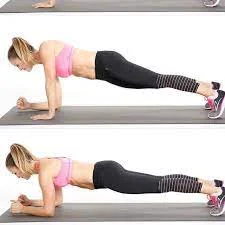
The workout routine targets other muscles in addition to your shoulders and core, working your entire body!
Start with your hands in a full plank.
Use your core to prevent your hips from swaying throughout this workout.
Gradually bring your left elbow down to the floor.
Bend your elbow to the right after that.
You should be in an elbow plank right now.
Put your left hand on the mat first, then your right, to return to a full plank position.
This should be done ten times.
Single-arm cross-body front lift
standing position.
Hold a dumbbell in each hand, palms facing away from the body.
Starting with your right hand, raise your arm straight up and across your body while keeping your core tight.
Gradually revert to your initial position.
To execute, use your left arm.
Continue to alternate between the two sides, doing 10 reps on each.
One-arm bent-over row:
What to do:
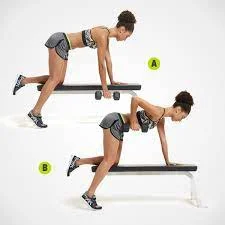
Put one hand and one knee on the bench. Retain your left elbow straight.
Slightly stretch your right leg behind you while keeping your foot firmly planted on the floor for support.
Stretch your right arm to the floor and bring it up to a medium-to-heavy dumbbell grasp.
Bend and pull your right elbow up and back until your upper arm is about in line with your lower chest.
When you reach the peak of the exercise, firmly squeeze your shoulder blades together.
Slightly lessen the weight.
Switch to the other arm after 10 to 12 repetitions on the first side.
Use no more than three sets.
Standing bend with a lateral lift
How to Proceed:
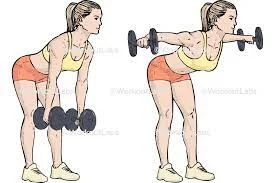
Hold a pair of dumbbells with your hands facing in opposing directions.
Place your feet shoulder-width apart, slump forward at the hips, and slightly bend your knees while maintaining a straight back.
The weights should be together beneath your chest, with your elbows relaxed.
Spread your arms wide like wings and raise them until they are parallel to the ground.
When the workout reaches its peak, tense your shoulder blades.
Slowly and carefully return the weights to their initial places.
Weights that are sufficiently light should enable 10–12 repetitions. Go up to 2-4 sets.
Callahan Press

Benefits: The Callahan press aids in full-shoulder development, and this exercise targets all three heads of the deltoids.
How to perform this workout for strengthening:
The patient must perform this exercise while standing with their feet hip-width apart and holding a dumbbell in each hand.
With the elbows bent up to ninety degrees, extend the arms out to the sides.
The hands should point up towards the roof, and the upper arms should be parallel to the shoulder joint. This is where you embark.
Stretch your forearms out in front of you and bring your palms up to your face.
Use the opposite motion to go back to the beginning position.
Move the weights straight past your shoulders and then back to your starting position by doing the opposite action.
That indicates a single repeat.
Perform one to two sets of ten to twenty repetitions.
Arnold Press standing
Advantages: It targets the three heads of the deltoid muscle and engages the triceps during the pressing motion.
How to perform this workout for strengthening:
Positioning their feet hip-width apart, the patient must grasp a dumbbell with both hands just below the chin, with their palms facing you.
Dumbbells should be pressed above you, and you should rotate your palms out until they are facing away from you.
After pausing at the peak, rotate your palms back towards yourself and descend the dumbbells down to the beginning.
Perform one to two sets of ten to twenty repetitions.
Jerk Press
Benefits include: This exercise works the patient’s deltoids, trapezius, and triceps in addition to helping to develop strength and power.
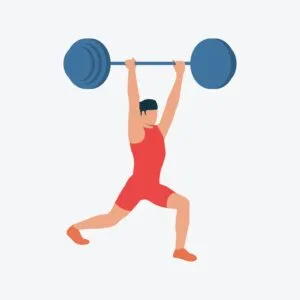
How to carry out this reinforcement:
The patient must perform this exercise by standing with their feet hip-width apart and grabbing two dumbbells in front of their shoulders with their hands facing each other. It is the initial position.
Press the weights aloft as you leap with your right foot forward and your left foot back in one powerful motion to land in a high lunge.
Returning to the embarkation posture with the front foot stepped, raise the weights to shoulder height.
Perform one to two sets of ten to twenty repetitions.
Hammer, curl, and press.
Benefits: This combination action works the deltoids as well as a variety of other upper-limb muscles, such as the triceps, biceps, and forearms.
How to perform this workout for strengthening:
The patient must stand with their feet hip-width apart, both hands on a dumbbell, and their arms at their sides with their palms facing each other in order to complete this exercise.
Keep your upper arms still while curling dumbbells up towards your shoulders with your elbows tucked in.
When the arms are stretched and the palms of the hands are facing each other, press the dumbbells above the head.
After lowering the weights back to the shoulders, extend the arms out to the sides in a straight line.
Perform one to two sets of ten to twenty repetitions.
Lateral Raises with the Standing Band

Stand shoulder-width apart, holding a resistance band in each hand at your side. Raise the band laterally, elbows locked at shoulder height. Slowly lower the band back to its starting position and repeat the action for ten reps three times.
TRX for the rear deltoid row
Hold the handles shoulder width apart, hands neutral, and lean backwards at a 45-degree angle. Pull the shoulder blades together and downward, then bend your elbows to pull your body towards your hands. Slowly return to the beginning posture while maintaining strong muscular control. Repeat 10–15 times for three sets.
The Military Press
This exercise targets the front deltoids and the key muscles in the upper arm region. To finish the exercise, stand with your feet hip-width apart and a dumbbell in each hand. Press the weights above the level of your head until your arms are fully stretched. Slowly return the weights to their initial position and repeat. Repeat for 5–10 reps over three sets.
Flies with alligator mouths
How to Proceed:

Place your feet hip-distance apart and stand with a dumbbell in each hand.
Bend your knees slightly and slant your hips forward.
Bring your abs in. Keeping your other arms hanging down, raise your right arm straight up in front of you until it is in line with your right ear.
Then, extend your left arm back behind you to contract your left tricep.
Imagine forming a single, diagonal, straight line with both arms.
Return to the starting point.
Alternate between reaching out with your right arm back and your left arm forward.
Continue for 15 reps on each side.
Tilted-Over Lateral Rise (Reverse Fly)
Benefits: This whole-body exercise works the obliques, glutes, quads, and all three segments of the deltoid muscle.
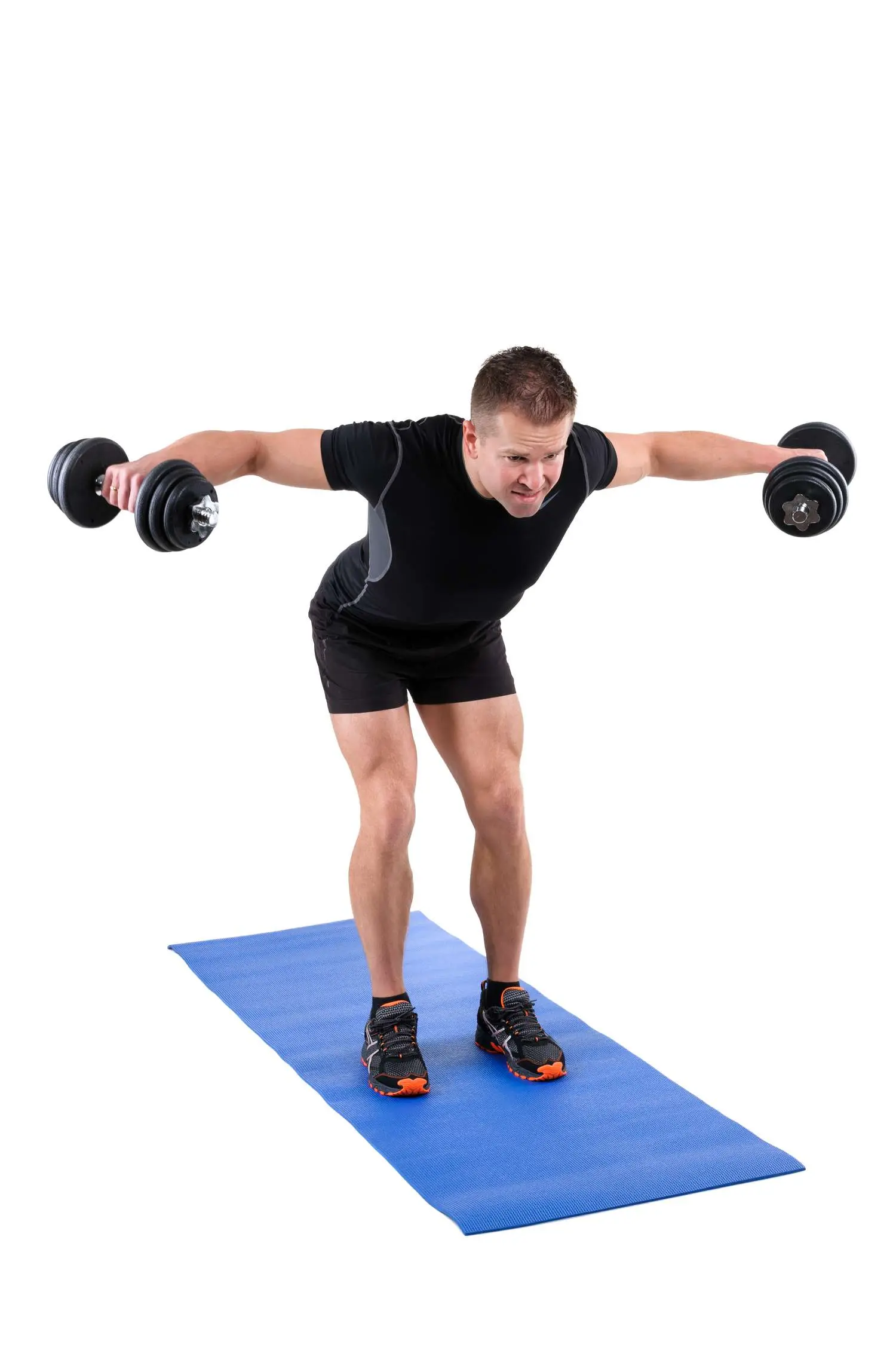
How to carry out this strengthening activity:
The patient must perform this exercise while standing with their legs wide apart and their toes turned 45 to 50 degrees. They must also hold a dumbbell in front of their chest with both hands. That is where things begin.
When descending slowly into a sumo squat, push your hips back; your back should remain straight.
Legs can be extended by pushing through the heels.
Dumbbells should be rotated around the head, starting from the right and going back to the right.
Continue the movement and turn both feet to the right as the patient brings the dumbbell to the front.
With both knees bent into a lunge, slowly descend a dumbbell in front of the front knee by straightening your arms.
Stretch your legs wide, turn your face forward again, and bring the dumbbell back up to your chest. On the left side, repeat.
Perform one to two sets of ten to twenty repetitions on each side.
EZ Bar Underhand Press while Seated
Benefits: Although this exercise may seem easy, it strengthens and stabilizes the shoulder by targeting the triceps, serratus anterior, and anterior head of the deltoid, the muscle that protects the ribs beneath the shoulder blade.
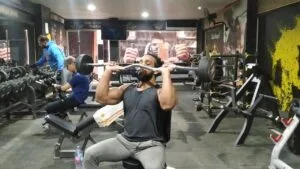
How to perform this workout for strengthening:
Sit on the seat after adjusting an inclined bench so that the back is vertical.
Use an underhand grip to hold an EZ Bar that has been loaded in the middle. Bringing the bar under the chin required bending the arms.
Pull a bar straight up above your head to lengthen your arms.
Return the barbell to just below the chin with a gradual motion, then repeat.
Perform 2 sets of ten to twenty repetitions.
Straight Row to Hip Lift
Benefits: This two-part exercise strengthens the biceps, trapezius, and medial heads of the deltoids, all of which contribute to the development of pulling strength.
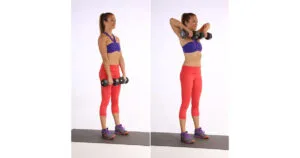
The patient must stand with their feet hip-width apart and grasp a pair of dumbbells in front of their thighs with their palms facing you in order to perform this strengthening exercise.
Raise the dumbbells to your chin in an upright row while keeping your chest up and your core active.
It is not appropriate to lift the elbows over the shoulders.
Lower your arms to your sides, bend your knees, push your hips back, and bend forward into a flat back.
With the palms facing back, let the arms hang straight.
Dumbbells should be raised behind you, arms straight, and shoulder blades drawn back.
Lower your arms and do it again.
Perform 3 sets of ten to twenty repetitions.
Lateral Raise with a dumbbell
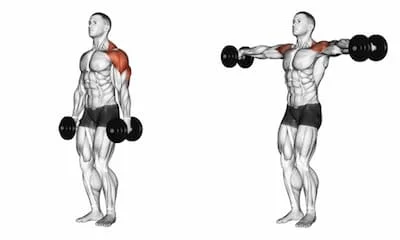
How to perform this workout for strengthening:
This exercise works the anterior and medial deltoid muscles, and it is quite efficient. The exercise also works the core, trapezius, and upper back.
Regarding this procedure Position your feet shoulder-width apart and stand upright. Dumbbells should be held in both hands using a pronated grip.
When the dumbbells are in line with the shoulders, slowly elevate the arms in an arc to the sides. Make sure your arms are parallel to the ground and avoid bending at the elbows.
Take a brief break and go back to the starting position.
Perform 1 to 3 sets of ten to twelve repetitions.
Push-ups in the decline position
How to perform this workout for strengthening:
The push-up is a well-known exercise for strengthening the chest’s pectoral muscles. A more difficult version of the push-up that targets the anterior deltoids more vigorously is the decline push-up.
The patient must perform this exercise while lying on the floor in a prone position with their hands shoulder-width apart.
Assume that the body is at an acute angle with the floor by placing the feet on an elevated platform.
The body should be just centimeters from the floor, and the elbows should be bent.
Raise the upper limb until the arms are parallel to the floor and completely straight. Return to the starting position after two seconds of holding that position.
Perform one to two sets of ten to twenty repetitions.
Lateral Cable Raises
Connect a low-pull cable machine to a D-handle.
With your feet shoulder-width apart, take a sideways stance towards the machine and grasp its handle with the hand that is furthest away from it.
Raise your arm straight out to the side until it is parallel to the floor, maintaining a small bend in your elbow.
Return the handle to its initial position by lowering it gradually.
After the specified number of repetitions, switch sides and repeat.
Cable-face Pulling
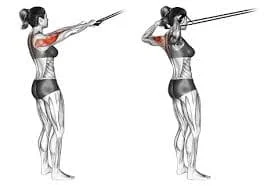
How to perform this workout for strengthening:
Left foot forward on a knee in front of the cable machine.
Grasp the handles with your palms pointing inward, then drag them towards your face to separate your hands.
After a few seconds of holding that position, return to the embarking position.
Perform one to two sets of ten to twenty repetitions.
External rotation on the side

How to perform this workout for strengthening:
The posterior deltoid’s outside motion is the main emphasis of the side-lying external rotation. Additionally, this exercises the teres minor and infraspinatus, two rotator cuff muscles.
The patient must perform this exercise while lying on their right side and carrying a light dumbbell in their left hand.
With the elbows bent at a 90-degree angle, place the left arm on the side. Position the towel roll in between the patient’s upper arm and trunk if their shoulders are broad.
As much as the patient is able to do so while keeping the upper arm on the body, rotate the arm on the trunk.
After holding for two to four seconds, gradually return this to its original position. Perform 1 to 3 sets of 15 repetitions.
Assisted Pull-ups
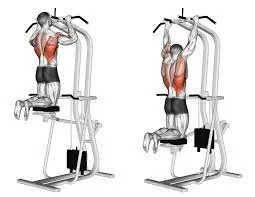
How to conduct this strengthening exercise: Although most people lack the upper limb strength to accomplish this exercise motion without assistance, it is a very effective one.
This exercise engages the latissimus dorsi, trapezius, and biceps, in addition to the posterior deltoids.
Adjust the weight calculation on the machine’s side. Decide on the right quantity and set. Climb onto the knee pad and press it down until the patient can comfortably rest both knees on it.
Make sure your knees are hip-width apart. With your palms facing away from the center, hold the outer handles above your head.
Lift your arms straight and descend to the starting position.
Raise your chin to meet or beyond the handles by pulling your torso upward.
Hold the posture for a few seconds before carefully lowering yourself.
Maintain the constricted shoulder blades as your main goal. They need to be lowered and pressed back.
Work your way up to ten repetitions by beginning with ten to twenty.
Push-Up (Pike Inverted Shoulder Press):
With your hands slightly wider than shoulder-width apart and your hips raised in the air to form an inverted V, begin in the push-up posture.
To keep your body stable, contract your core muscles.
Bending your elbows while maintaining their outward orientation, lower your head towards the floor.
Arms straightened, press through your palms to raise your body back up to the starting position.
When performing the activity, concentrate on engaging your deltoid muscles and shoulders.
Continue until the desired number of times.
Rows with barbells upright
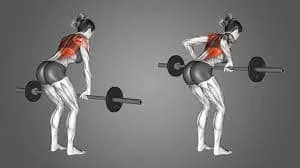
How to perform this workout for strengthening:
The anterior and middle heads of the deltoids are worked during the barbell upright row.
The patient must stand with their feet shoulder-width apart for this exercise. Next, take hold of the barbell and let it hang in front of you at arm’s length. Maintain your hands in line with your thighs and your palms towards your body.
Breathe deeply and tense your abdomen. The posture should be straight back, chest elevated, and forward-gazing eyes.
Exhale and raise a bar straight up, towards the chin.
Hold the barbell close to your body and guide with your elbows.
It is acceptable for the arms to extend slightly below the shoulder height, but no higher.
Take a minute or two at the top of the lift.
As you inhale, lower the bar to return to the starting position.
Perform 1 to 3 sets of ten to fifteen repetitions.
When did the patient stop doing the Deltoid strengthening exercise?
The patient should not perform this exercise if he already has shoulder pain.
if a recent fracture to the arm bone happens.
Stay away from weightlifting activities if the patient has back pain.
If, throughout this workout, the patient experiences any pain or discomfort in their shoulders.
2. Deltoid muscle stretching
Throughout the day, the shoulders exert a lot of effort. The patient requires them to reach, pull, lift, push, sit up straight, and even walk. They may have discomfort or stiffness after an exercise in addition to feeling tight or even exhausted at times. Deltoid stretches are a suitable means of maintaining shoulder suppleness.
The patient has a slight risk of shoulder pain and injury if these muscles are flexible and loose. Stretching for the three deltoid muscle groups—the anterior deltoids, which are located on the front of the shoulders, the lateral deltoids, which are located on the top of the shoulders, and the posterior deltoids, which are located in the lower back of the shoulder joints—will help prevent imbalance. These three components each have distinct purposes.
How do you stretch your deltoid?
The ideal exercise for the patient to perform at home to release the tight deltoid muscles is the one that follows.
Anterior deltoid stretch
What is the process?
Maintain a straight posture with your feet hip-width apart. Your shoulders should be relaxed, tucking your scapulae down to match your spine on either side.
Keeping the elbows straight, grasp the hands behind the back and elevate them away from the body. Stop the patient there and hold them there for 15 to 30 seconds if they start to feel stretched.
When moving, avoid bending your body in any way; instead, remain upright.
Hold the towel between the patient’s palms if they are having trouble clasping them together.
Repeat the stretch 3 times.
There are several versions to the anterior deltoid stretch:
- Isolation of internal rotation
- Doorway stretching
- Bridge position stretch
- Isolating internal rotation
Target just the anterior deltoids by isolating internal rotation.
How to carry out Place yourself in a supine position and extend your arms past your shoulders. Raise one hand such that the forearm and elbow are at a straight angle to the body and the elbow is 90 degrees from the body. The hand should descend gradually until it rests at the side of the body. After a few moment of holding that stretch, go back to your beginning posture.
Execute three to four sets of twenty reps. Apply to a different arm.
As far as the patient can reach without experiencing pain, lower the arm. As much as the patient is able, perform repeats; gradually, get better. The patient can raise weight in advance, specifically with a dumbbell, while stretching.
2. Stretching a doorway
How to carry out Place your feet hip-width apart and stand upright in the doorway.
With the elbow slightly bent, place the right hand on the doorway, just below shoulder level.
Shift your torso away from your right arm. Hold the position for ten to twenty seconds once the patient feels stretched. Next, proceed to the left side.
Any stationary item, like a wall or vertical bar, can be used by the sufferer to grasp.
3. Stretch in the bridge position
Method: Assume a seated posture. Both the knees and the feet should be bent so that they are flat on the ground.
The fingers of the hand are pointing forward and it is placed next to the body.
Inhale, raise your body from the floor into a bridge position, and press your hands and feet into the ground. Both the thighs and upper body are parallel to the ground. One at a time, straighten your legs without lowering your hips into a bridge stance. Now let your head drop and relax your neck.
After holding that posture for thirty seconds, take the starting position and reverse the motion.
Beginning with 5-second holds and working their way up to longer durations.
Breathe slowly and deeply while the patient maintains the position, inhaling through the nose and exhaling through the mouth.
Stretch of the lateral deltoid
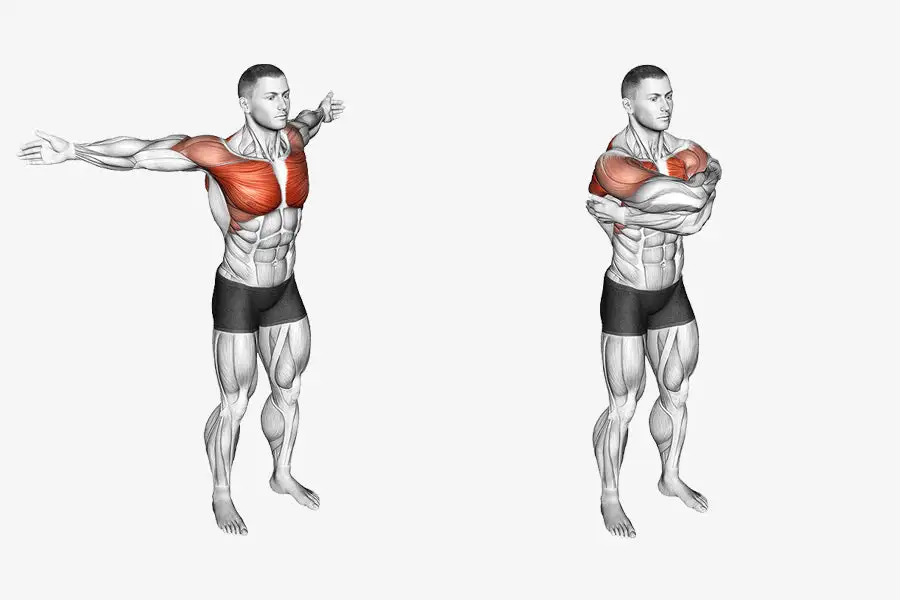
Another name for this is the cross-body deltoid stretch.
How to carry out Place your feet hip-width apart and stand upright. With the elbow slightly bent, place the left hand across your body or even horizontally in relation to it.
Using your right hand, grasp the end of the upper arm just above the elbow.
Now use your right hand to press the left hand against your body.
Hold the position for 30 seconds when the patient starts to feel stretched. Next, proceed to the right side.
The shoulder remains relaxed throughout the motion.
Variations in lateral deltoid stretch include:
Method: Assume a standing position adjacent to a table or bench, with your hips approximately hip-width apart.
With your left hand resting on the table for support, bend forward. Now, slowly swing your right arm in both directions, just like a pendulum hanging on a tabletop.
While performing the action, do not move your body. The knee is slightly bowed, but the back is straight. Proceed to repeat the circular motion in a side-to-side manner.
Not only do it on the left arm, but also turn around.
Perform ten repetitions in three sets.
How to do it: Place your feet hip-width apart, stand upright, and maintain a straight back.
With your right arm behind your back and your elbow flexed 90 degrees, pose. Hold that elbow now with your left elbow.
Next, use the left hand to draw the right elbow towards the left back.
Hold the position for 15–30 seconds once the patient feels stretched.
Do the same with your left hand.
Work on each side for three sets.
Posterior deltoid stretching
How to do it: Begin with stretching your crossover. Pull back your shoulders gently so that your scapulae rest on either side of your spine.
Grab one hand horizontally across the body and place the other hand over the upper arm.
Start slowly drawing that arm and the other side up against your chest. Stop there as soon as the patient feels overextended.
Repeat on the opposite side after holding the position for 30 seconds.
Perform three iterations on each side.
Variations in posterior deltoid stretch include:
- Stretching when sleeping
- bent over in the horizontal abduction position
1. Stretching when sleeping
Ways to carry out This makes the muscles that support it active. To ensure that the forearm is at the proper angle to the body, assume a side-lying position with the lower arm 90 degrees bent.
To push the arm downward, use the other arm. After 30 seconds of holding the position, if the patient feels stretched, offer them a 30-second break.
On a different side, repeat the stretch. During the wrist stretch, avoid bending or applying any pressure.
2. Bent over the stretch of horizontal abduction
How to accomplish it: Assume the prone posture with one arm dangling out of a bench or even the edge of a bed.
Without bending the arm, begin by holding the dangling arm straight and gently raising it to eye level.
At this point, gradually return to the beginning position.
Perform three sets of ten repetitions, then go on to the opposite arm.
Lift the arm just to the extent that the patient is able to tolerate pain. It then adds some weight after the patient masters it.
Stretch a bear hug dynamically
A vigorous bear hug stretches the chest and the anterior and posterior deltoid muscles.
It’s the ideal motion to do right before working out.
How to perform this exercise: Place your feet shoulder-width apart and stand upright. Make sure your posture is upright and that your core is active.
Extend your arm widely and at a 90-degree abduction.
Bring the arms across the chest when the patient feels a slight stretch in front of the shoulders and chest. Attempt to give yourself a hug with your left arm resting on top of your right. The rear of the patient’s shoulder feels stretched.
Swing the arm in the embarking position in a controlled motion. Prior to the arms returning to a hugging posture, try to reach the end of the range of motion. The right arm is over the left arm this time.
After 30 seconds, stop and take a break. Do two more rounds of this.
Downward dog with modifications
Both the anterior deltoids and the chest have been targeted with a modified downward dog. Additionally, because it stretches the hamstrings, glutes, and low back, it is the finest method for improving posture.
Additionally, because it is comfortable to stretch, it is simple to perform at work.
How to perform a stretch Take a straight stance behind the sturdy chair, desk, or even table. Set your feet hip-distance apart.
Now, contract your core and maintain proper posture while standing.
Place the arms outstretched and the hands flat on a desk.
While doing a stretch, make sure your arms, back, and legs are all straight; just your hips should be flexing.
Breathe deeply, then start moving backward until your body forms the inclination. Now tilt your hips downward and your upper body forward. As the patient reclines, extend the arms above the head.
Hold this position until the patient feels stretched in both the chest and the front of the shoulders.
For thirty seconds, hold that. Do it 2 more times.
What are the health benefits associated with stretching the deltoid muscle?
Stretching the deltoid muscle can have several advantages.
Here are a few of them:
Both the deltoid muscle’s range of motion and flexibility should be increased.
Reduce your level of stress and shoulder tightness.
Boost your posture with your body.
Reduce the likelihood of both a sprain and an injury to the shoulder.
Enhance sports performance.
When should I not perform the Deltoid muscle exercise?
If you already have shoulder pain, avoid doing uncomfortable exercises.
If your arm bone was recently shattered,
If you have back pain, avoid weightlifting exercises.
Avoid excessive exercise.
Avoid doing hard-lifting workouts. Gradually increase the number and weight of dumbells.
If you feel any soreness or discomfort in your shoulder while performing this workout,
If you have pain, a sprain, or bursitis, do not do it.
Deltoid workouts at home
Walking plank. Begin with a high plank stance
Upright row. Hold a dumbbell with both hands, resting in front of your thigh.
Rear Delt Fly
Lateral Raise
Plank with Shoulder Taps
Burpee
Single-Arm Dumbbell Press,
Rear Delt Fly.
Deltoid Exercises for Women
Dumbbell Front Raise. It is stabilised by the core and targets the pectoralis and anterior deltoid muscles.
Dumbbell Lateral Rais
Overhead Shoulder Press.
Bent Over: Reverse Fly
Dumbbell Arnold Press & Upright Row
Deltoid exercises with dumbbells:
Side lateral press
Overhead press
Arnold press
Dumbells shoulders press
Reverse fly
Front rise
Deltoid exercises without weights:
Push-ups. This exercise starts in a push-up position with your arms straight and hands shoulder-width apart
Handstand Push-ups.
Begin the workout by standing in front of a wall.
Wall Walks
Incline Push-ups
Shoulder Taps
Bear Crawls
Plank Rockers
Plank Walks
Rear deltoid exercises:
Dumbbell Reverse Fly
Resistance Band Face Pull
Inverted Row
Dumbbell Bent-Over Row
Dumbbell Y-T-I Raise
Dumbbell Arnold Press
Bodyweight Cobra on Stability Ball
FAQs:
What are the deltoid muscles and their locations?
The deltoid muscles, often known as the delts, are placed on the outside of the shoulder and have three heads: anterior (front), lateral (middle), and posterior (rear). They define the rounded curve of the shoulder.
Why is it necessary to exercise the deltoid muscles?
Exercise of the deltoid muscles is beneficial for shoulder stability, functional mobility, sports performance, posture support, injury prevention, and aesthetics. Strong deltoids improve overall shoulder health and physical performance.
What exercises work the muscles of the deltoid?
Shoulder presses, lateral rises, front raises, reverse flyes, Arnold presses, and upright rows are all good workouts for strengthening the deltoid muscles. These workouts, which can be done with dumbbells, barbells, or machines, focus on various deltoids.
How often should my deltoid muscles be trained?
Deltoid muscles can be worked out two to three times a week, but in order to allow for muscular growth and recovery, there should be at least one day off in between sessions. To prevent injury, it’s critical to pay attention to your body and refrain from overtraining.
Is it possible to train the deltoid muscles at home without any equipment?
Yes, you can use bodyweight exercises like wall walks, plank push-ups, pike push-ups, and shoulder taps to conduct deltoid exercises at home without any equipment. Resistance bands can also be used to increase resistance in exercises like front rises and lateral raises.
Are there any safety measures I should follow when performing deltoid muscle exercises?
Yes, it’s crucial to complete deltoid exercises with the correct form and technique to prevent injury. As you acquire strength, progressively increase resistance by starting with lighter weights. Before beginning a new workout regimen, speak with a healthcare provider if you have a history of shoulder pain or injury.
How can I strengthen my deltoid muscles without risking shoulder injuries?
It’s critical to warm up properly before working out, to use correct technique when performing exercises, to avoid lifting excessively high weights, and to progressively raise the intensity of your workouts over time in order to prevent shoulder problems. Furthermore, including rotator cuff exercises can help enhance shoulder stability and lower the chance of injury.
If I experience pain or discomfort in my shoulder, can I still engage in deltoid muscle exercises?
It’s important to consult a healthcare provider if you have shoulder pain or discomfort before doing more deltoid exercises. To prevent aggravating the condition, specific adjustments or different workouts could be advised, depending on what’s causing the pain.
How long do deltoid muscle exercises take to show results?
Exercises targeting the deltoid muscles might yield different outcomes over time, based on a variety of factors, including frequency of training, intensity of workouts, diet, and genetics. It usually takes a few weeks to several months to see significant gains in shoulder strength, size, and shape with regular training and a healthy diet.
Reference:
- Cscs, J. C. M., & Cscs, J. C. M. (2024, February 13). Deltoid Workouts. ATHLEAN-X. https://athleanx.com/articles/shoulders-for-men/deltoid-workouts
- Cnc, E. R. C. (2024, February 14). The 8 Best Deltoid Exercises for Your Shoulder Workout. Transparent Labs. https://www.transparentlabs.com/blogs/all/deltoid-workouts
- Cpt, K. S. (2023, March 10). 6 Exercises to Improve Posterior Deltoid Strength. Healthline. https://www.healthline.com/health/fitness-exercise/rear-delt-exercises
- 12 deltoid exercises to tone and strengthen your shoulders. (2023, November 28). TODAY.com. https://www.today.com/health/diet-fitness/best-deltoid-exercises-rcna43495
- Deltoid. (n.d.). Physiopedia. https://www.physio-pedia.com/Deltoid
- D. (2022, November 15). Deltoid muscle exercise. Mobility Physiotherapy Clinic. https://mobilephysiotherapyclinic.net/deltoid-muscle-exercise/#Health_benefits_of_Deltoid_exercise
- Prajapati, N. (2022, August 23). Deltoid muscle stretching exercise: Health Benefits, How to Stretch? Samarpan Physiotherapy Clinic. https://samarpanphysioclinic.com/deltoid-muscle-stretching-exercise/
- Prajapati, N. (2022, December 28). Deltoid muscle strengthening exercise has health benefits. How to do? Samarpan Physiotherapy Clinic. https://samarpanphysioclinic.com/deltoid-muscle-strengthening-exercise/

